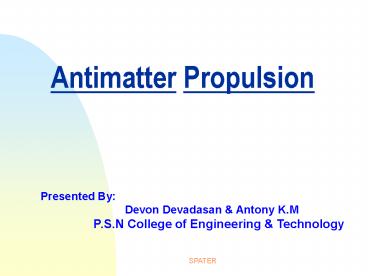Antimatter Propulsion - PowerPoint PPT Presentation
1 / 17
Title:
Antimatter Propulsion
Description:
Antimatter Propulsion Presented By: Devon Devadasan & Antony K.M P.S.N College of Engineering & Technology SPATER Contents What is an Antimatter? Origin of an ... – PowerPoint PPT presentation
Number of Views:717
Avg rating:3.0/5.0
Title: Antimatter Propulsion
1
Antimatter Propulsion
Presented By Devon
Devadasan Antony K.M P.S.N
College of Engineering Technology
2
Contents
- What is an Antimatter?
- Origin of an Antimatter
- Principle behind Antimatter Propulsion
- Different types of Antimatter Engine
- Advantages
- Disadvantages
- Conclusion
- Queries??
3
What is an Antimatter?
- Antimatter has the same mass but its electrical
charges are reversed - it is believed that in the Big Bang equal
quantities of matter and antimatter were created - They are literally the mirror images of matter
4
Origin of Antimatter
- In 1930 Paul Dirac discovered that the antimatter
should exist - In 1932 Carl Anderson discovered Positron
- In 1950 physicist at the Lawrence Radiation
laboratory used the Bevatron accelerator to
produce antimatter
5
Principle Behind Antimatter propulsion
- Annihilation is the principle behind Antimatter
Propulsion - The colliding particles matter and antimatter is
converted into radiant energy in the form of
gamma rays - The collision between an electron and a
anti-electron have a combined rest mass of 1.02
MeV - Gamma rays have a characteristic energy of 0.511
MeV.
6
Different types of Antimatter Engine
- Matter-Antimatter Engine .
- Positron Based Engine
7
Matter-Antimatter Engine
- Matter-Antimatter propulsion 100 of the mass of
the matter and antimatter is converted into
energy - Matter-antimatter reactions are 1,000 times more
powerful than the nuclear fission - It has the potential to take us farther with less
fuel
8
Different types of antimatter rocket propulsion
system
- Solid Core Antimatter Rocket
- Plasma Core Antimatter Rocket
- Beam Core Antimatter Rocket
- Gas Core Antimatter Rocket
9
Solid core Propulsion system
- The antiprotons are used to heat a sold metal
core usually tungsten - The tungsten absorbs the gamma rays and pions
from the antimatter/matter annihilation and is
heated. - The hydrogen gas enters, the tungsten core is
cooled while the hydrogen gas is heated and is
then expanded through a nozzle to produce thrust .
10
Plasma Core Antimatter Rocket
- Antiprotons are injected to annihilate and heat
the plasma. - Heat is rapidly transferred to the propellant
- Thrust released out of the vehicle at a very high
velocity.
11
Beam Core Antimatter Rocket
- In a beam core, the charged particles of the
antiproton annihilation are directly released
out. - Charged particles are released out of the vehicle
along an axial magnetic field. - Anti-protons are released at a very high
velocity near the speed of light
12
Gas Core Antimatter Rocket
- Energy is transferred to liquid/gas propellant
directly heated by annihilation gamma rays. - Annihilation occurs in the hydrogen propellant.
The charged pions are controlled in magnetic
fields and superheat the hydrogen - specific impulse of 2500 secs.
13
Advantages
- Very high specific impulse
- large amount of energy from a small amount of
fuel - can able to achieve long flight in a short period
14
Disadvantages
- Very high risk of gamma radiation
- Very difficult to produce antimatter
- Complicated engine designs
- High manufacturing cost
15
Conclusion
- Due to the highest specific impulse of this
propulsion we can even achieve the speed of
light - we need a reliable method of producing large
amount of antimatter.
16
Queries??
17
Thank you































